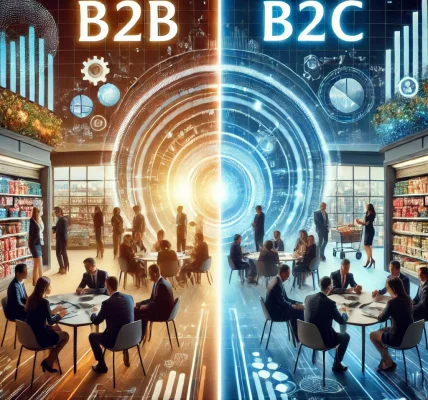E-commerce has transformed the way consumers shop and businesses operate, driven by technological advancements, evolving consumer behaviors, and a growing digital economy. With global e-commerce sales projected to reach new heights, businesses must adapt to emerging trends to remain competitive.
This blog explores the future of e-commerce, key market trends, and the growth potential that businesses can leverage in the coming years.
1. The Current Landscape of E-commerce
Global E-commerce Market Overview
E-commerce has witnessed exponential growth, fueled by:
- Increased internet penetration and mobile device usage.
- The rise of digital payment solutions.
- Changing consumer preferences for convenience and personalized experiences.
- Advancements in logistics and last-mile delivery solutions.
Impact of the COVID-19 Pandemic
The pandemic accelerated digital transformation, making e-commerce the primary shopping channel for millions. Businesses adopted online-first models, leading to permanent shifts in retail strategies.
2. Key Market Trends Shaping the Future of E-commerce
a) The Rise of Mobile Commerce (M-Commerce)
- Mobile shopping accounts for a significant portion of online sales.
- Businesses optimize their websites and apps for seamless mobile experiences.
- Features like one-click checkout and mobile wallets enhance convenience.
b) Social Commerce Expansion
- Platforms like Instagram, TikTok, and Facebook integrate shopping features.
- Influencer marketing and live-stream shopping drive engagement and sales.
- Businesses leverage user-generated content to build trust and brand awareness.
c) AI and Personalization in E-commerce
- Artificial Intelligence (AI) enhances product recommendations and customer service.
- Chatbots and virtual assistants improve customer interactions.
- Predictive analytics help retailers understand shopping behaviors and trends.
d) Voice Commerce and Smart Assistants
- Growth of voice-activated shopping through Alexa, Google Assistant, and Siri.
- Businesses optimize product listings for voice search.
- Convenience-driven shopping experience leads to higher adoption rates.
e) Augmented Reality (AR) and Virtual Reality (VR) Integration
- AR-powered try-before-you-buy features for fashion, furniture, and beauty.
- VR showrooms enhance the online shopping experience.
- Businesses use immersive technologies to reduce return rates.
f) Sustainability and Ethical Shopping
- Consumers prefer eco-friendly and sustainable brands.
- Businesses adopt green packaging, carbon-neutral shipping, and ethical sourcing.
- Transparency in supply chains attracts environmentally-conscious shoppers.
3. Growth Potential and Business Strategies
a) Expanding into Emerging Markets
- E-commerce growth is booming in Asia, Africa, and Latin America.
- Businesses localize content, pricing, and payment methods.
- Investing in regional logistics networks ensures efficient delivery.
b) Omnichannel Retailing for Seamless Shopping
- Integration of online and offline experiences.
- Click-and-collect and same-day delivery enhance customer convenience.
- Unified inventory management optimizes stock availability.
c) Subscription-Based Business Models
- Growth of subscription services for curated shopping experiences.
- Businesses enhance customer retention through loyalty programs.
- Recurring revenue models provide financial stability.
d) Blockchain and Secure Transactions
- Blockchain technology enhances payment security and transparency.
- Cryptocurrency adoption in e-commerce transactions is rising.
- Smart contracts streamline B2B e-commerce operations.
e) Leveraging Data Analytics for Customer Insights
- Businesses utilize big data to refine marketing strategies.
- Predictive analytics enhance demand forecasting and inventory management.
- AI-driven pricing models optimize revenue generation.
4. Challenges and Considerations
a) Cybersecurity and Data Privacy
- Rising cyber threats require robust security measures.
- Compliance with data protection laws (GDPR, CCPA) is crucial.
- Businesses prioritize encryption, multi-factor authentication, and secure transactions.
b) Logistics and Last-Mile Delivery Issues
- Meeting consumer expectations for fast and free shipping.
- Managing supply chain disruptions effectively.
- Investing in automation and drone delivery solutions.
c) Regulatory and Taxation Challenges
- Compliance with international e-commerce laws.
- Understanding digital taxation policies in different regions.
- Implementing transparent pricing and duty calculation mechanisms.
5. Conclusion: The Future of E-commerce
The future of e-commerce is shaped by technology, changing consumer demands, and market dynamics. Businesses that embrace innovation, prioritize customer experience, and adapt to emerging trends will thrive in the competitive e-commerce landscape.
By leveraging AI, mobile commerce, social shopping, and sustainability initiatives, businesses can maximize growth potential and build a resilient online presence. As digital transformation continues, e-commerce will remain a dominant force in global commerce, offering new opportunities for businesses to expand and evolve.




